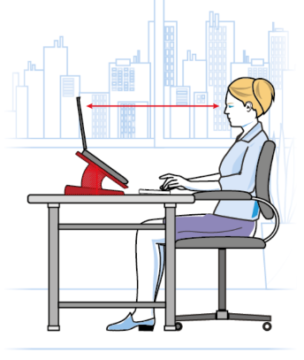Work Ergonomics
What is Work Ergonomics?
Ergonomics is the study of people in their working environment more specifically. The goal is to eliminate discomfort and risk of injury due to work.
There are certain basic ergonomic guidelines that may help an employee avoid back pain or back injury.
- Develop a job description based on the forces present in a particular work environment; the time spent performing the task and the biomechanics (which define human motions and seated posture in an office chair used in the task.
- Use body posture as a tool that can be changed to meet the job demands with minimum stress on the muscles, ligaments, bones and joints.
- Learn and use appropriate body mechanics to limit extra mechanical stress in completing the task.
- Maintain fitness and flexibility and develop a reserve of strength.

How can we identity Poor Posture and Risks?
Many potentially harmful situations that lead to back injury can be identified and avoided by following four basic rules of thumb:
1. Prolonged static posture is the enemy. The healthy body can only tolerate staying in one position for about 20 minutes. That is why sitting on an airplane, at a desk in an office chair, or at a movie theatre becomes uncomfortable after a short time. Standing in one place, such as standing on a concrete floor at an assembly line for extended periods of time tends to cause back pain. Holding the same position slowly diminishes elasticity in the soft tissues (muscles, ligaments, and tendons in the back). Then, stress builds up and causes back discomfort and/or leg discomfort.
The solution is simple. Whether you’re sitting in an office chair or standing in a line, change positions frequently. Just move. Stand or sit, stretch, take a short walk. After returning to the standing or sitting posture, use an alternate posture for just a few moments and some of the tissue elasticity needed to protect the joints will return.
2. Frequent or repetitive stretching to the end range of motion or awkward, angled postures can bind the joints. Unlike jobs that require long-term seating in an office chair, jobs that require frequent repetitive motion can cause great discomfort. Such jobs involve lifting from the floor, lifting overhead, moving bulky loads, or using rotational force or twisting while handling material and which signal back injuries might be on the way.
- Heavy loads offer greater risk. If the job requires moving heavy or bulky objects, it is important to have the proper tools or get help.
- Fatigue from sitting in an office chair for days, from work or from insomnia can make people move more awkwardly. If one is overtired or feels fatigued, it is advisable to avoid lifting heavy objects alone or quickly.
Contact
FILL IN THE FORM
FOR APPOINTMENT
For Emergency
We Are Open Always 24 hrs | 365 Days
Call: 8657500555 | 8657500666
